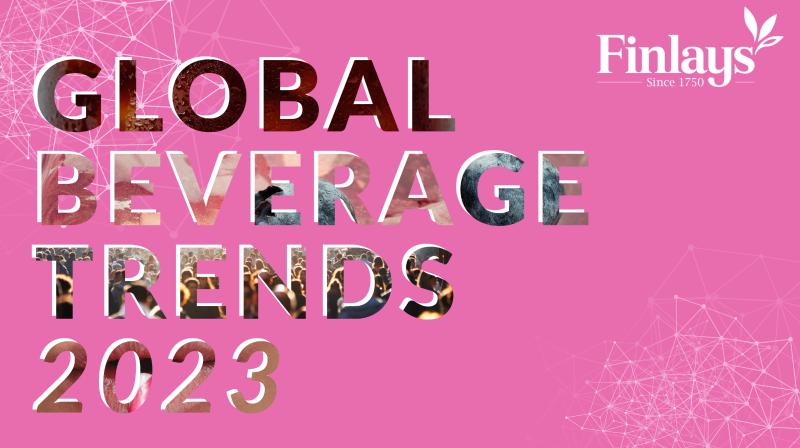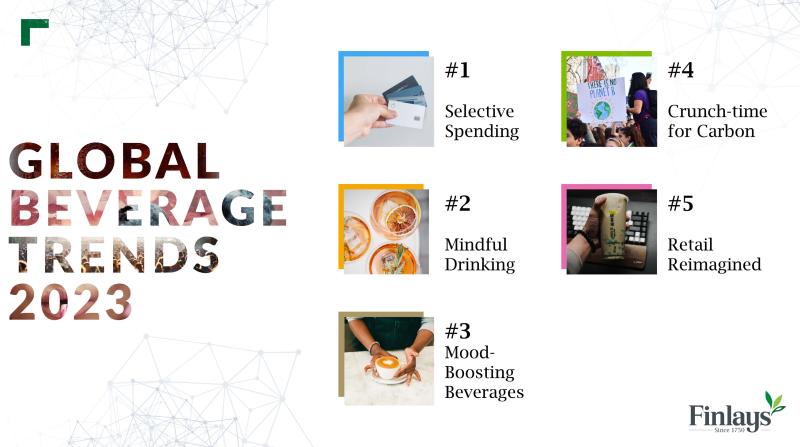“Selective spending,” “mindful drinking,” “mood boosting beverages” and “retail re-imagined” are some of the major trends the beverage industry should be getting ready for in 2023, according to Finlays, a leading B2B tea, coffee and botanical solutions provider.
As part of its annual Global Beverage Trends Report, Finlays outlined five key trends, which it believes will shape natural beverages and products over the next year and beyond.
Sian Edwards, Finlays’ group insights manager, said, “The events of the last 12 months feel just as seismic as the previous 12, with continued volatility in global economics, supply chains and politics continuing to cause major changes in how consumers purchase beverage products.”
Despite these challenges, Edwards believes that the outlook for the industry is positive.
“Globally, consumers are seeking to make good choices for the planet, and for themselves,” Edwards said. “While we expect to see belts tightening, we’re also already seeing the return of the beverage as an ‘affordable indulgence,’ creating opportunities for innovation and value creation. Consumers’ continued interest in healthy and sustainable beverages is also an important opportunity for brand owners.”
World Tea News spoke with Edwards to get insights on each of the key 2023 beverage trends from the report, along with insights on how tea fits in and how the tea industry can respond in the New Year.

1. Selective Spending
Following the boom in “revenge spending,” which saw people splurge as lockdowns eased, consumers are now facing a raft of financial challenges, per the Finlays report. Spending caution will therefore be a major trend in 2023 (and beyond), but Finlays expects to see a focus on “affordable luxury” as consumers seek cost effective ways to keep their spirits up. Beverage brand owners who can offer consumers a gloom-busting taste of affordable indulgence luxury will be in an advantageous position.
In terms of advice for the tea industry, Edwards noted, “There is an immediate need for tea brands and suppliers to balance the cost-of-living crisis with the consumer desire for affordable indulgence. Fortunately for companies in our industry, tea is a highly inelastic product and critically important to many people’s daily routines. Additionally, when consumers look to cut down on foodservice spend, the role of hot drinks at home grows increasingly important as a cheaper alternative. So, look for ways to grow and innovate, particularly within the retail channel, offering consumers an inexpensive way to treat themselves, and experiment with formats and flavors.”
2. Mindful Drinking
Millennials and Gen Z are drinking alcohol less and more mindfully than previous generations. They’re also much more receptive to new beverage concepts, spurring the development of new niche and hybrid categories, as explained in the Finalys report. As a result, the beverage industry has been highly responsive to changing consumer behavior, with innovations spanning the alcohol alternative, low alcohol and RTD alcohol categories, as brand owners look to capture share in this fast-growing market segment.
For the tea industry, this trend is a real opportunity for tea brands and suppliers, with high growth of “hard” iced teas and alcohol alternatives using botanicals, according to Edwards. “Look for ways to develop low/no alcoholic drinks with more sophisticated ‘adult’ flavor profiles, and investigate the role of tea in botanical-led non-alcoholic spirits,” said Edwards. “Longer term, we are expecting to see growth in ‘functional’ beverages as an alcohol alternative, which tea is well-placed to capitalize on, as 57 percent of consumers believe green tea has a positive impact on their health [per GlobalData plc, 2022].”
3. Mood Boosting Beverages
“Permacrisis” was named the word of the year for good reason. After the challenges of the COVID-19 pandemic, and with financial pressure mounting, consumers are increasingly looking to ease stress with products that support mental wellbeing, as identified in the new report. These range from products that create a sense of treat and relaxation, to those that promise functionality. Beverages can be central to this trend – the role of hot tea infusions in moments of relaxation is prevalent in most cultures globally, while caffeinated beverages such as iced coffee are often consumed for a more active boost.
Edwards explained, “Hot tea and infusions have long been established in many cultures globally, as a comforting, mood-boosting beverage, so there is an immediate opportunity for tea brand owners and suppliers to take advantage of this trend. Look for ways to develop blends that strike an emotional chord with consumers, using traditional, accessible flavors such as biscuit-inspired brews or dessert flavors.”

4. Crunch-Time for Carbon
In 2022, many looked at the importance of traceability, and companies demonstrated tangible actions to reduce their impact on the planet – from packaging to sourcing strategies. For 2023, there will be a laser focus on carbon emissions – as Finlays noted in the report – as government legislation, consumer awareness and rising energy costs intersect to bring this trend to the fore.
“With long and often complicated supply chains to navigate, measuring, reducing and off-setting carbon within the tea industry is a longer-term challenge,” shared Edwards. “Immediate next steps for brands are to work with suppliers to put in place processes to start measuring carbon to develop trackable, tangible science-based targets [SBTI]. Gaining greater insights into supply chains and seeking transparency will set up tea brands to succeed in this space.”
5. Retail Re-Imagined
COVID hugely accelerated the uptake in online shopping, per the Finalys report, changing the way consumers purchase goods. This trend is taking shape in a number of ways including traditional ecommerce e.g. through retailers building online presence, direct to consumer models (such as brand subscriptions) and the growing area of social media shopping e.g. TikTok shop. This is a challenge for the beverage landscape, with products typically being tricky and expensive to ship, but brands are starting to adapt.
“Hot tea and infusions are well-positioned for e-commerce, as shelf-stable products with a long shelf-life and relatively lightweight ingredients and packaging, so there’s a real opportunity for brand owners to position products better in the online space, such as optimizing packaging design for online sales,” explained Edwards. “Brand owners could also investigate direct-to-consumer models such as subscriptions, highlighting the breadth and depth that camellia sinensis has to offer.”
To read the full Global Beverage Trends Report 2023, click here.
Plan to Attend or Participate in the
World Tea Conference + Expo, March 27-29, 2023
To learn about other key developments, trends, issues, hot topics and products within the global tea community, plan to attend the World Tea Conference + Expo, March 27-29, 2023 in Las Vegas, co-located with Bar & Restaurant Expo. Visit WorldTeaExpo.com.
To book your sponsorship or exhibit space at the World Tea Conference + Expo, or to enquire about advertising and sponsorship opportunities at World Tea News, contact:
Ellainy Karaboitis-Christopoulos
Business Development Manager, Questex
Phone: +1-212-895-8493
Email: [email protected]
Also, be sure to stay connected with the World Tea Conference + Expo on social media for details and insights about the event. Follow us on Twitter, Facebook, Instagram and LinkedIn.
